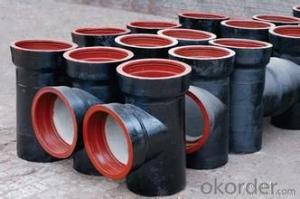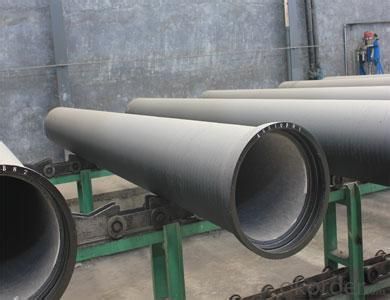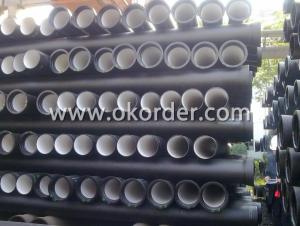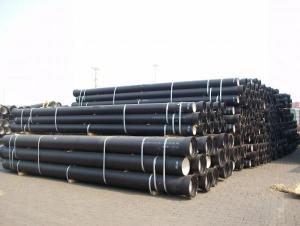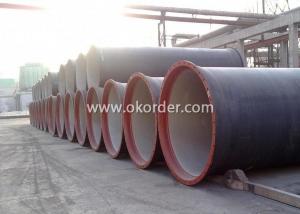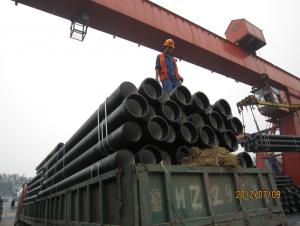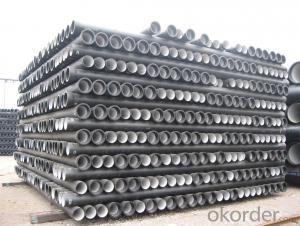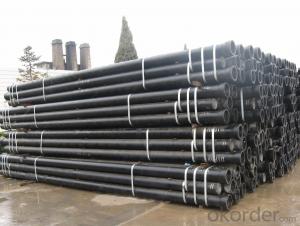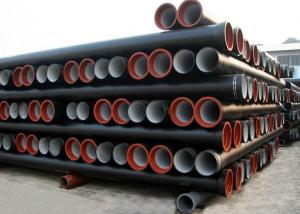DUCTILE IRON PIPES C Class DN200
- Loading Port:
- China Main Port
- Payment Terms:
- TT OR LC
- Min Order Qty:
- -
- Supply Capability:
- -
OKorder Service Pledge
OKorder Financial Service
You Might Also Like
Ductile Iron Cast Pipe is without any defects compare with tradition casting tech, which has many advantages particularly as follow:
(1) High density. In the "vertical upward casting" process, the melt iron of centre liquid column in center crystallizer is continuously feeding for volume shrinkage caused by condensation tube at outer circumference , which lead to be free of shrinkage porosity.
(2) High purity. When melt iron pouring, the mixed impurities such as gas, dross, sand grain which are lighter than melt iron could be eliminated at furnace mouth, its impossible to enter into the crystallizer through the channel, so the melt iron into the crystallizer is very pure.
(3) Strength with toughness. The cooling speed provided by continuous crystallizer is 30 times than sand casting and 5 times than centrifugal casting, and doesn't produce white iron, the eutectic cell volume of continuous cast iron is one eighth to one tenth compare with traditional cast iron. The density of graphite nodule in ductile iron can reach 300-700 pcs/mm2. Therefore, all reason above improve the strength and toughness of continuous cast iron.
(4) Free machining. The high speed cooling make the hardening phase (such as boride, steadite) not appear like reticular, massive or thick, but diffuse like fish bone and pane in shape, moreover, there are tiny graphite flakes inlaid hardening phase. It's free machining in BrinellHardness the range of 250-300HB. However, the Brinell Hardness of 250 is top limit to common metal materials.
(5) Uniform composition of tube wall. The convection mixing of liquid column caused by marching type drawing in crystallizer make the composition of tube wall well-distributed, and concentration gradient very little.
(6) High productivity. To the wall thickness of tube under 10mm, the speed of continuous casting is 1 meter/min, to the wall thickness of tube under 20mm, the speed of continuous casting is 0.5 meter/min, which is high efficiency that centrifugal or other casting tech couldn't reach.
- Q: What is the expected joint tightness for ductile iron pipes?
- Ductile iron pipes are renowned for their exceptional strength and durability, which grants them remarkable resistance against leaks and joint failures. Consequently, the joints in these pipes are meticulously designed to establish a secure and tight connection, effectively minimizing any potential water or fluid loss. In the realm of ductile iron pipes, a variety of joint types are commonly employed. These encompass mechanical joints, restrained joints, and push-on joints. Each of these joint types is uniquely crafted to deliver a reliable seal, effectively averting any leakage. Mechanical joints rely on a combination of a mechanical gland and rubber gaskets to forge an airtight seal. The assembly of these joints necessitates a specific level of torque to ensure proper compression and sealing. On the other hand, restrained joints are specifically tailored to withstand external forces, such as soil movement or pressure, while simultaneously preserving their tightness. To achieve this, these joints often incorporate a mechanical restraint system, such as a key-locking mechanism, thereby preventing joint separation. Meanwhile, push-on joints represent the most straightforward option to install, as they rely on a compressed rubber gasket that effectively seals the pipes when pushed together. These joints are most commonly employed in smaller diameter pipes, where external forces exerted on them are minimal. All in all, ductile iron pipes are expected to exhibit a high level of joint tightness, ensuring consistent and leak-free performance across a wide array of applications, including water distribution, wastewater systems, and industrial piping networks.
- Q: Can ductile iron pipes be used for water distribution networks?
- Water distribution networks can utilize ductile iron pipes. Ductile iron, a type of cast iron known for its strength and flexibility, is well-suited for a variety of applications, including water distribution systems. Due to their durability, resistance to corrosion, and long lifespan, ductile iron pipes have been widely used in water supply networks. These pipes are capable of withstanding high pressure and are resistant to external loads and ground movement, making them an ideal choice for underground installations. Additionally, ductile iron pipes are commonly used for transporting safe drinking water as they are non-toxic and do not contaminate the water supply. Moreover, ductile iron pipes possess excellent hydraulic properties, ensuring efficient water flow and minimizing friction losses. Their smooth interior surface prevents the accumulation of deposits, reducing the risk of clogs and maintaining a consistent water flow. In summary, ductile iron pipes offer a reliable and effective solution for water distribution networks, guaranteeing the safe and efficient transportation of water to communities and industries.
- Q: Maximum pipe diameter of ductile iron pipe
- Price even if it is not clear, you can consult the ball mill cast iron pipe manufacturers!
- Q: What are the different types of joints used with ductile iron pipe?
- There are several different types of joints that can be used with ductile iron pipe. These joints are designed to provide a secure and watertight connection between sections of pipe. Some of the most common types of joints used with ductile iron pipe include: 1. Mechanical Joint: This is the most commonly used joint for ductile iron pipe. It consists of a gland and a follower which are tightened using bolts and nuts to provide a tight seal. Mechanical joints are flexible and can accommodate slight misalignments. 2. Push-On Joint: This type of joint does not require any bolts or nuts. It is designed to be easily assembled by simply pushing the pipe sections together. A rubber gasket is used to provide a watertight seal. 3. Restrained Joint: Restrained joints are specifically designed for applications where pipe movement needs to be limited. These joints typically include a mechanical joint with additional features such as thrust collars or tie rods to prevent axial movement. 4. Flanged Joint: Flanged joints are commonly used for larger diameter pipes. The pipe ends are flanged and then bolted together, with a gasket placed in between to create a leak-proof connection. Flanged joints are typically used in applications where frequent disassembly and reassembly may be required. 5. Welded Joint: In some cases, ductile iron pipe sections may be welded together using a fusion welding process. This creates a permanent and strong joint. Welded joints are commonly used in high-pressure applications where a reliable and durable connection is required. It is important to note that the choice of joint type will depend on the specific requirements of the project, such as the pipe diameter, pressure rating, and the nature of the fluid being transported. Additionally, local regulations and standards may also dictate the type of joint that should be used in certain applications.
- Q: What is the K9 standard pressure for ductile iron pipes?
- The annealed ductile iron pipe is composed of ferrite and pearlite. The mechanical properties of the ductile iron pipe are better. Ductile iron pipes mainly called centrifugal ductile iron pipe, it has the properties of nature, iron and steel, excellent corrosion resistance, good ductility, good sealing effect, simple installation, mainly for municipal, industrial and mining enterprises, water supply, gas, oil etc.. Water supply pipe is the first choice, with high cost performance. Compared with the PE pipe, from the installation time, ductile pipe PE pipe installation is simple and rapid, and after the installation of internal and external pressure bearing better tightness and corrosion resistance; from the point of view, ductile pipe sealing better after installation, but also can improve the corrosion resistance of corrosion protection through a variety of means; from the hydraulic performance, because ductile pipe specifications generally refers to the inner diameter of PE pipe diameter specifications generally refers to the same specifications, because under the condition of ductile pipe can achieve greater runoff; from the installation and maintenance cost, ductile pipe have more favorable price. The main components of ductile iron pipes are carbon, silicon, manganese, sulfur, phosphorus and magnesium. The inner wall of zinc spray, anti-corrosion materials such as cement mortar.
- Q: Are ductile iron pipes available for cutting and are there any relevant specifications?
- Ductile iron pipes can be divided into cutting and non cutting pipes, the cutting pipe can be cut, and the cutting pipe is usually marked with "scissors" mark in the pipeline.
- Q: How does ductile iron pipe compare to PVC pipe in terms of performance and cost?
- Ductile iron pipe and PVC pipe are two commonly used materials for various piping applications, and they have distinct differences in terms of performance and cost. In terms of performance, ductile iron pipe is known for its exceptional strength and durability. It is highly resistant to internal and external pressures, making it suitable for carrying water, sewage, and other fluids under high pressure conditions. Ductile iron pipe also has an excellent resistance to corrosion and can withstand extreme temperature variations. Moreover, it has a longer lifespan, often lasting over 100 years, which makes it a reliable choice for long-term projects. On the other hand, PVC pipe is renowned for its versatility and ease of installation. It is lightweight, making it easier to transport and handle during installation. PVC pipe is also resistant to chemicals, making it suitable for applications where corrosion may be a concern. However, PVC pipe may not be as durable as ductile iron pipe, especially when subjected to external pressure or harsh environmental conditions. It may also be susceptible to cracking or breaking under extreme temperatures. In terms of cost, PVC pipe is generally less expensive than ductile iron pipe. PVC pipe is manufactured using less costly materials and is easier to produce, resulting in lower production costs. Additionally, the lightweight nature of PVC pipe reduces transportation costs and makes installation more efficient. Ductile iron pipe, on the other hand, tends to be more expensive due to the higher costs associated with its manufacturing process and the heavier weight, which requires additional handling and transportation expenses. Ultimately, the choice between ductile iron pipe and PVC pipe depends on the specific requirements of the project. If strength, durability, and longevity are crucial, ductile iron pipe may be the preferred option despite its higher cost. However, for applications that require versatility, ease of installation, and cost-effectiveness, PVC pipe can be a suitable alternative.
- Q: How does ductile iron pipe perform in areas with high soil compaction?
- Ductile iron pipe performs exceptionally well in areas with high soil compaction. One of the key advantages of ductile iron is its high strength and durability, which allows it to withstand heavy loads and pressures. In areas with compacted soil, where there is a greater likelihood of ground movement and settling, ductile iron pipe's superior structural integrity ensures that it remains intact and can effectively handle the stress. Additionally, ductile iron pipe has excellent resistance to corrosion. This is particularly important in areas with high soil compaction, as the compacted soil can often contain high levels of moisture or chemicals that may accelerate the corrosion process. Ductile iron's inherent resistance to corrosion helps maintain the pipe's integrity over time, even in challenging soil conditions. Another advantage of ductile iron pipe is its flexibility. This material has a high degree of flexibility, allowing it to absorb and distribute external loads more effectively. In areas with high soil compaction, where the ground may shift or settle, ductile iron's flexibility helps to minimize the risk of pipe failure or damage. Furthermore, ductile iron pipe has a smooth interior surface, which helps to improve its hydraulic performance. In areas with high soil compaction, where there may be limited space for proper compaction around the pipe, the smooth interior minimizes the risk of sediment buildup or clogging, ensuring efficient water flow. Overall, ductile iron pipe is an excellent choice for areas with high soil compaction. Its strength, corrosion resistance, flexibility, and hydraulic performance make it a reliable and durable option that can withstand the challenges posed by compacted soils.
- Q: Are ductile iron pipes suitable for wastewater pumping stations?
- Yes, ductile iron pipes are suitable for wastewater pumping stations. Ductile iron is a strong and durable material that can withstand the harsh and corrosive nature of wastewater. It has excellent resistance to abrasion, corrosion, and impact, making it a reliable choice for wastewater applications. Additionally, ductile iron pipes have a high tensile strength and can handle high-pressure situations, making them suitable for pumping stations where wastewater needs to be transported over long distances or through elevated areas. The smooth interior surface of ductile iron pipes also helps to minimize friction and enhance the flow of wastewater, reducing the risk of clogging or blockages. Overall, ductile iron pipes provide a cost-effective and long-lasting solution for wastewater pumping stations.
- Q: How do ductile iron pipes perform in freeze-thaw cycles?
- Ductile iron pipes perform well in freeze-thaw cycles due to their high tensile strength and flexibility. Unlike brittle materials, ductile iron can withstand the expansion and contraction caused by freezing and thawing without cracking or breaking. This makes them a reliable choice for water and sewer systems in regions with harsh winter climates.
Send your message to us
DUCTILE IRON PIPES C Class DN200
- Loading Port:
- China Main Port
- Payment Terms:
- TT OR LC
- Min Order Qty:
- -
- Supply Capability:
- -
OKorder Service Pledge
OKorder Financial Service
Similar products
Hot products
Hot Searches
Related keywords
